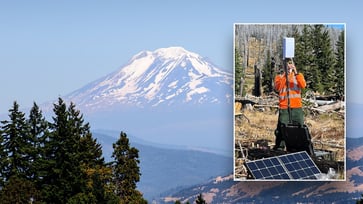In the US, the Joro spider is becoming more prevalent, but it's not the invasive species that poses a threat.
Joro spiders, with their distinctive bright yellow and black coloring, can reach lengths of up to three inches when their legs are fully stretched.

- For years, the population of the large, brightly colored invasive species known as the Joro spider has been growing in parts of the southern and eastern U.S. Some researchers predict that it will only be a matter of time before they spread to much of the continental U.S.
- Spiders native to East Asia do not possess venom harmful to humans.
- The Joro spider's invasion serves as a cautionary tale of the potential harm another species with greater environmental damage capabilities might inflict.
The Joro spider, a large, brightly colored invasive species, is expanding in the United States. Its populations have been growing on the South and East Coast for several years, and many researchers predict that it will soon spread to most of the continental U.S.
But spider experts say we shouldn’t be too worried about them.
"David Nelsen, a professor of biology at Southern Adventist University, stated that his belief is that people are drawn to the unusual, thrilling, and possibly hazardous. This phenomenon, he believes, is a perfect match for public panic."
The increasing occurrence of invasive species that harm our crops and trees is a growing concern among scientists, exacerbated by global trade and climate change, which enables pests to thrive in previously inhospitable conditions.
Hannah Burrack, professor and chair of the entomology department at Michigan State University, stated that the species in question is a "canary in the coal mine" type species, meaning it is showy and attracts a lot of attention. However, she emphasized that the shy critter poses little risk to humans. Instead, she pointed out that introduced pests like fruit flies and tree borers can cause more harm.
The global concern is that it makes managing conservation, agricultural production, and human health more difficult.

WHAT IS THE JORO SPIDER?
Orb-weaver spiders, known for their wheel-shaped webs, are native to East Asia and can grow as long as three inches when their legs are fully extended. These spiders have bright yellow and black coloring.
It is challenging to detect them at present because they are in their early stages of development, measuring only the size of a grain of rice. However, their softball-sized webs on front porches or their gossamer threads of golden silk covering the grass can be spotted with a trained eye. Adults are most commonly observed in August and September.
WHERE ARE THEY HEADED?
David Coyle, an assistant professor at Clemson University, stated that scientists are still trying to determine the range of Joro's population, which is primarily located in Atlanta but is expanding to the Carolinas and southeastern Tennessee. Additionally, a satellite population has established itself in Baltimore over the past two years.
The research suggests that the species may become more prevalent in the Northeast, but the exact timeline is uncertain. It may take several incremental steps over a period of time.
CAN THEY FLY?
Joro spiders can travel long distances using a tactic called "ballooning" and their webs, but you won't see fully-grown spiders taking flight.
WHAT DO THEY EAT?
Joro spiders, which mainly feed on insects, could compete with native spiders for food, but their daily catch could also feed native bird species, as documented by research scientist Andy Davis at the University of Georgia.
Coyle stated that there is "zero chance" that Joro spiders, despite some observers' hope, will significantly reduce the population of invasive spotted lanternflies damaging trees on the East Coast.
ARE THEY DANGEROUS TO HUMANS?
Joro spiders possess venom like all spiders, but their bite isn't deadly or medically significant to humans. At most, a Joro bite may cause itching or an allergic reaction. However, these elusive creatures usually avoid human contact.
The emerald ash borer and spotted wing drosophila, two other creatures, could potentially harm humans by damaging the natural resources we depend on.
"I strive to maintain a scientifically objective perspective on the issue, which helps me avoid becoming overwhelmed by the sadness it brings. However, the extensive ecological damage occurring globally due to various reasons, primarily human activities, is a concerning example of mankind's impact on the environment."
science
You might also like
- Lunar modules from the first two moon landings have been captured in stunning detail by Orbiter photos, more than 50 years after the historic missions.
- Discovery of a remarkable mastodon jaw in a New York homeowner's backyard
- NASA resumes communication with Interstellar Voyager 1 after pause.
- In 2055, the asteroid that was once referred to as Earth's "mini moon" will make a return visit.
- A new species of sea slug that resides in the ocean's 'midnight zone' has been discovered with a glowing appearance.



















